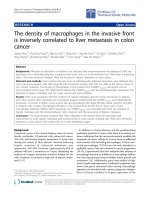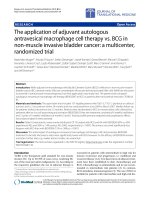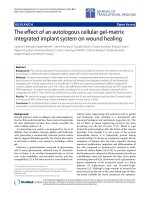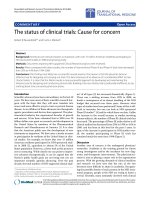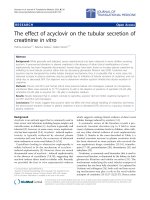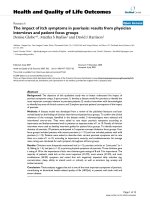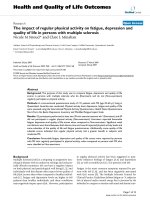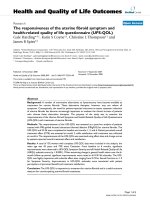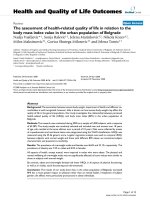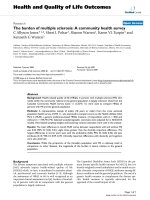báo cáo hóa học:" The ability of cancer-specific and generic preference-based instruments to discriminate across clinical and self-reported measures of cancer severities" doc
Bạn đang xem bản rút gọn của tài liệu. Xem và tải ngay bản đầy đủ của tài liệu tại đây (271.87 KB, 10 trang )
RESEARCH Open Access
The ability of cancer-specific and generic
preference-based instruments to discriminate
across clinical and self-reported measures of
cancer severities
Paulos Teckle
1,2,3*
, Stuart Peacock
1,2,3
, Helen McTaggart-Cowan
1,2
, Kim van der Hoek
1,2
, Stephen Chia
4
,
Barb Melosky
4
and Karen Gelmon
4
Abstract
Objective: To evaluate the validity of cancer-specific and generic preference-based instruments to discriminate
across different measures of cancer sev erities.
Methods: Patients with breast (n = 66), colorectal (n = 57), and lung (n = 61) cancer completed the EORTC QLQ-
C30 and the FACT-G, as well as three generic instruments: the EQ-5D, the SF-6D, and the HUI2/3. Disease severity
was quantified using cancer stage, Eastern Cooperative Oncology Group Performance Status (ECOG-PS) score, and
self-reported health status. Comparative analyses confirmed the multi-dimensional concep tualization of the
instruments in terms of construct and convergent validity.
Results: In general, the instruments were able to discriminate across severity measures. The instruments
demonstrated moderate to strong correlation with each other (r = 0.37-0.73). Not all of the measures could
discriminate between different groups of disease severity: the EQ-5D and SF-6D were less discriminative than the
HUI2/3 and the cancer-specific instruments.
Conclusion: The cancer-specific and generic preference-based instruments demonstrated to be valid in
discriminating across levels of ECOG-PS scores and self-reported health states. However, the usefulness of the
generic instruments may be limite d if they are not able to detect small changes in health status within cancer
patients. This raises concerns regarding the appropriateness of these instruments when comparing different cancer
treatments within an economic evaluation framework.
Keywords: Quality of life, cancer-specific instruments, generic instruments, external validity: responsiveness, disease
severity, utilities
Introduction
Cancer is the leading cause of death in many developed
countries. In Canada, the latest statistics confirm that can-
cer-related mortality is now higher than mortality from
circulatory diseases [1]. As such, the demand for effective
and efficacious treatments is rising. New cancer therapies
are being developed, and approved, with the aim of
improving a patient’s prognosis [1,2]. These treatments,
however, often have a detrimental effect on the patient’s
quality of life (QOL). As the therapies are administered in
accordance to the patient’s severity level, it is important to
have a valid QOL instrument which can discriminate
across all levels of disease severity. This is of importance
to oncologists as defining prognostic determinants may
aid in the stratification of randomization on known prog-
nostic factors in clinical trials and in therapeutic decision-
making in routine practice while maintaining a high level
of QOL for the patient.
QOL can be evaluated using either disease-specific or
generic preference-based instruments. Disease-specific
* Correspondence:
1
Canadian Centre for Applied Research in Cancer Control (ARCC), Vancouver,
BC, Canada
Full list of author information is available at the end of the article
Teckle et al. Health and Quality of Life Outcomes 2011, 9:106
/>© 2011 Teckle et al; licensee BioMed Central Ltd. This is an Open Ac cess article distributed under the terms of the Creative Commons
Attribu tion License ( which permits unrestricted use, distribution, and reproduction in
any medium, provided the original work is properly cited.
instruments have the capacity to detect minimal changes
in a specified health condition [3]. In oncol ogy, the two
most widely used instruments to assess QOL are the
European Organization of Research and Treatment in
Cancer (EORTC) Quality of Life Core 30 ( QLQ-C30)
and the Functional Assessment of Cancer Therapy -
General (FACT-G) [4,5]. While the advantage of using
cancer-specific instruments is their capacity to detect
minimal changes in a disease, these instruments are not
suitable for comparisons across different disease states.
Asaresult,theuseofgenericpreference-basedinstru-
ments is a better option. The advantage of generic
instruments is that they integrate different aspects of a
health state into a single index anchored by a value of
one for perfect health and zero for dead. This value can
be combined with the length of time in that health state
to generate a quality-adjusted life year (QALY), a metric
used in economic e valuations [6]. The most commonly
used generic preference-based instruments are the Euro-
Qol5D(EQ-5D),theShortForm6D(SF-6D),andthe
Health Utilities Index (HUI) [7-9].
The use of generic preference-based instruments can
be incorporated into a general health policy model to
compare the efficiency of different programs or treatment
strategies [6]. This pro vides a framework for decisions
concerning the adoption of new treatments within a pub-
licly-funded health care system. However, generic instru-
ments typically cover dimensions of health such as
mobility, pain, activity limitation, and anxiety or depres-
sion; these dimensions may not be sensitive, or relevant,
to treatment effects for the health condition under inves-
tigation [3]. This may be due, in part, as to why many
cancer trials do not inc lude generic preference- based
instruments; instead, focusing on cancer-specific instru-
ments to evaluate outcomes of patients.
Currently, the validity of QOL instruments to discrimi-
nate between different levels of cancer severity has not
yet been adequately evaluated. Therefore, the objective of
this study is to evaluate the validity of cancer-specific and
generic preference-based instruments in terms of their
ability to distinguish between different measures of can-
cer severity. Disease severity was measured in three ways:
cancer stage; Eastern Cooperative Oncology Group
Performance Status (ECOG-PS) score; and patient-
reported general health status.
Methods
Study Participants
To participate in the study, patients had the following
criteria: be diagnosed w ith either breast, colorectal, or
lung cancer; be 18 years and older; be able to speak and
read English; have a life expectancy of at least six months;
be without cognitiv e impairments; and have pl ans to
return to an appo intment with a medical oncolo gist.
Breast, colorectal, and lung cancer were chosen as they
are among the most common cancers diagnosed in Brit-
ish Columbia and Canada [1,2]. Recruitment and
informed consent were undertaken by a medica l onc olo-
gist. Consented patients were given the questionnaires to
complete at a subsequent outpati ent visit at the Vancou-
ver Cancer Clinic.
To complete the study, patient s had two options avail-
able to them. The instruments cou ld be completed face-
to-face with a trained research assistant at the patient’s
appointment. Alternatively, the patients could take the
instruments home and post the completed forms in a pro-
vided pre-paid envelope. For both options, researchers
were available to answer questions if needed. The order of
the QOL instruments was randomized for each partici-
pant. The study protocol was approved by the Research
Ethics Board of the British Columbia Cancer Agency.
The study was piloted with 66 cance r patients at the
Vancouver Cancer Clin ic. The objectives of this pilot
study were, not only to determine the practicality of col-
lecting five QOL measures in terms of administration and
respondent burden, but also to estimate the median, mean
and standard deviation (SD) of the different QOL mea-
sures; the latter provided the estimates to calculate a sam-
ple size for the main study.
Based on results from the pilot study and other prefer-
ence-based instruments, a difference of 0.05 in mean uti-
lity measures of health states is considered important and
meaningful [10,11]. Using 80% power to detect a differ-
ence in mean health state of 0.05 between different sever-
ity groups and assuming that the common SD is 0.10
using an independent t-test at the 5% significant level indi-
cates that a minimum sample size of 32 in each group is
needed. The mean (SD) for the EQ-5D, SF-6D, HUI-2,
and HUI-3 were 0.81 (0.17), 0.71 (0.11), 0.83 (0.13), and
0.76 (0.23), respectively. To compare differences in mean
health scores, we will need a sample of 62, 38, 53, and 167
respondents for EQ-5D, SF-6D, HUI-2, and HUI-3 respec-
tively. We therefore collected data from 182 patients.
Data Collection
Socio-Demographic and Clinical Information
Data pertaining to the patients’ socio-demographic infor-
mation were obtained using a self-administered question-
naire. The patient’ s cancer status, in terms of disease
stage and ECOG-PS score, was extracted from their med-
ical records. The stage of cancer is typically classified
fromstage1tostage4;thehigherthestage,themore
aggressive and fast growing the cancer. The ECOG-PS is
a single item rating of the degree to which patients are
able to participate in typical activities without a need for
rest. The scale, ranging from zero (fully active) to five
(dead), assesses disease progression and its impact on the
patient’s daily living abilities [12]. The ECOG-PS was
Teckle et al. Health and Quality of Life Outcomes 2011, 9:106
/>Page 2 of 10
chosen because it is a powerful predictor of QOL and an
important concern in cancer care [13]. In addition to the
clinical measures, the patientprovidedaself-reported
health status; this was measured on a seven-point
response scale, ranging from excellent to fair to extre-
mely poor.
Cancer-Specific Instruments
For this study, two cancer-specific instruments were
used: the EORTC QLQ-C30 and the FACT-G [4,5]. The
QLQ- C30 dominates cancer clinical trials in Canada and
Europe, while the FACT-G is more widely used in the
USA [14]. T he QLQ-C30 and the FACT-G contain dif-
ferent items even though they cover the same scales or
dimensions, respectively.
The QLQ-C30 is a 30-item questionnaire compo sed of
multi-item scales and single items to reflect the multidi-
mensional nature of QOL in cancer [4]. It incorporates
five functional scales (i.e., physical, role, cognitive, emo-
tional, and social), three symptom scales (i.e., fatigue, pain,
and nausea and vomiting), and seven single items (i.e., dys-
pnea, appetite loss, sleep disturbance, constipation, and
diarrhea); these are measured o n a four-point response
scale. The instrument also contains an item assessing the
perceived financial impact of the disease and treatment
and two seven-point response scales pertaining to global
health and QOL. While the QLQ-C30 does not yield an
overall score, a global health status score was created from
the patients’ responses to the two response scales relating
to global health and QOL [15,16].
The fourth version of the FACT-G consists of 27 items
covering four dimensions of well-being: physical, social/
family, emotional, and functional [5]. Items within these
dimensions are evaluated on a five-point response scale.
Using the instrument developer’s algorithms, an overall
score and four dimension scores can be generated with
higher scores reflecting better QOL. Reliability and valid-
ity, including responsiveness, of the instrument have been
well documented in canc er trials and clinical settings
[17-19].
Generic Instruments
The EQ-5D questionnaire consists of a general health
descriptive system based on five items and a 100-point
visual analogue scale. The five items cover mobility, self
care, usual activities, pain/discomfort, and anxiety/depres-
sion with three levels per item (i.e., no problem, some pro-
blems, and extreme problems). The instrument describe s
243 possible health states, which are assigned utilities
based on country-specific algorithms developed by the
EuroQol group. The most widely used utility algorithm
was based on a time trade-off (TTO) survey of 2997 UK
respondents [9]. Recently, Shaw et al [20] developed a uti-
lity algorithm based on TTO responses from 4048 US resi-
dents. In the absence of a Canadian algorithm, this wa s
used to calculate EQ-5D utilities for this study.
The SF-6D was cons tructed fro m a sample of 11 items
selected from the Short Form 36 (SF-36). These items
were valued by a representative sample of the UK general
population using the standard gamble (SG) [21,22]. This
is a six-dimensional health state classification system
with each dimension having four to six levels; therefore,
18,000 health states are described. In place of a Canadian
utility algorithm, the UK population tariff was used.
A version of the HUI instrument that combines features
of the HUI mark 2 (HUI-2) and HUI mark 3 (HUI-3) was
used in this study. The HUI2/3 contains 15 items that
focuses on aspects of vision, hearing, speech, emotion,
pain, mobility, dexteri ty, cognition, and s elf-care; eac h
item was defined by four to six levels. Using the responses
on the HUI2/3, two different utilities were estimated using
an algorithm developed from random samples of the
Canadian population: one for the HUI-2 and one for the
HUI-3 [7].
Data Analysis
Descriptive statistics were used to characterize the sample
in terms of age, sex, marital status, ethnicity, employment
status, education level, and annual income. In addition to
these socio-demographic variables, the patients were char-
acterized by disease severity. Continuous variables are pre-
sented as means and SDs while categorical variables are
presented as the proportion of the sample within each
group. The QOL scores of the i nvestigated instruments
are reported as Tukey’svalues.
Before testing the ability of the instruments to discrimi-
nate across disease-severity measures, the psychometric
properties of the cancer-specific instruments in terms of
internal consistency and construct validity were examined.
Internal consistency was evaluated using Cronbach’s alpha
coefficient [4,5] and convergent validity using correlation
coefficients [23]. Construct validity assesses whether scales
from different instruments, measuring similar dimensions
of QOL, are strongly correlated with each other. Both
parametric and non-parametric (Pearson and Spearman)
correlation coefficien ts were calculated; however, as the
results were statistically similar, results from the Pearson’s
correlation coefficients are reported. A coefficient of
greater than 0.5 or less than -0.5 indicates a strong corre-
lation between instruments, 0.30 to 0.49 or -0.49 to -0.30 a
moderate correlat ion, and value s between 0.30 to -0.30 a
weak correlation [24]. We also compared the correlation
between the general health scores from the cancer-specific
instruments and the utility indices from the preference-
based instruments. A Bonferroni correction was applied to
counteract the problem of multiple comparisons [25].
The external validity o f each instrument was assessed
based on its ability to discriminate between different can-
cer severity as represented by cancer stage, ECOG-PS
score, and self-reported health status. This was determined
Teckle et al. Health and Quality of Life Outcomes 2011, 9:106
/>Page 3 of 10
using the instruments’ global scores. Patients with the
greatest disease severity (i.e., cancer stage 4, ECOG-PS
score 3, and very poor self-reported health) were hypothe-
sized to have lower QOL scores across all instruments.
One-way analysis of variance (ANOVA) evaluated the dif-
ferences among QOL scores when stratified by the afore-
mentioned variables of disease severity.
The effect size, the standardized mean difference
between two groups on a measured outcome, was also cal-
culated. Each of the disease severity variables were sub-
divided into two meaningful groups of sufficient size: can-
cer stages 1-2 versus cancer stages 3-4; ECOG-PS 0 versus
ECOG-PS 1-3; self-reported health status excellent-good
versus self-reported health status fair-very poor. Stage 3
and stage 4 were grouped together because the aim was to
compare late stage disease with those patients in stages 1
and 2 (early disease stages). The reason why the ECOG-PS
1-3 categories a re collapsed together is due to the small
number of patients in PS 3 (n = 5). T he decision was
made to differentiate patients who reported “no problem”
with their daily lives (PS 0) and those who reported some
level of problems (PS 1-3). While it might appear slightly
counterintuitive to combine the fair self-rating with poor
and very poor, the decision was based purely on the num-
ber of patients belonging in the two groups: excellent-
good (n = 116) and fair-very poor (n = 63); including the
‘fair’ respondents with the ‘excellent-good’ would result in
only 27 patients in the ‘poor-very poor’ group.
An effect size of one indicates a clinically meaningful
change in magnitude equivalent to one standard deviation
(SD). The absolute value of effect sizes (d) can be categor-
ized as small (d = 0.2 -0.5), medium (d = 0.5-0.8), or large
(d > 0.8) [26]. By comparing the effect sizes across the dif-
ferent cancer-specific and generic preference-based instru-
ments, their discriminative abilities can be assessed
[26,27]. All analyses were performed using the STATA
statistical software package, version 11.1 [28].
Results
Patient Characteristics
One hundred and ninety five patients were approached
to participate in the study. All gave consent to partici-
pate in the study. The questionnaires were completed
by184patients;ahighresponserateof94%was
achieved. The average (SD) time to complete the study
was 22.3 (8.9) minutes. Most patients required no assis-
tance in completing the instruments.
The socio-demographic and clinical characteristics of
the patients are described in Table 1. The majority of
patients were females (65%) and the mean (SD) age was
58.5 (11.5) years. In total, the patient sample consisted of
66 (36%) with breast cancer, 57 (31%) with colorectal can-
cer, and 61 (33%) with lung cancer. Although half of the
patients were reported to be in cancer stage 4, 64 (36%)
had an oncologist-reported ECOG-PS score of 0 (i.e., fully
active, able to carry on all pre-dise ase performance with-
out restriction); no ECOG-PS score worse than 3 was
reported. Most of the patients reported to being in very
good (26%) and good (29%) health state s. As only five
patients had an oncologist-reported ECOG-PS score of 3,
these individuals were combined with the adjacent group
to form the ECOG-PS 2-3 group.
Quality of Life Scores
Table 2 displays a summary of the QOL scores obtained
from the instruments used in this study. For the generic
preference-based instruments, a maximum score of 1.0
was achieved but the minimum values varied. The SF-6D
and HUI-3 had inte rquartile ranges (IQRs) of 0.14 and
0.17, respectively, which is lower than those of the EQ-
5D (IQR = 0.22) and the HUI-2 (IQR = 0.31). The mean
(SD) values between the two cancer-specific instruments
differed; such that patients valued their QOL higher
using the FACT-G (81.61 (14.14)) when compared to the
QLQ-C30 (68.90 (20.36)). Seventeen (9%) patients had a
best possible s core for the global health status score of
the QLQ-C30; none provided the best possible score for
the FACT-G. Fourteen of these part icipants gave a score
of greater than 0.95 for the HUI-2 and HUI-3; 11 gave
the best possible scores for the EQ-5D, and the SF-6D.
Paired t-tests indicated no significant differences in
mean scores of the generic preference-based instru-
ments between females and males; married and not
married; and Caucasian and non-Caucasian (results not
presented). Mean EQ-5D and HUI-2 scores were found
to be higher for more educated participants. We found
no significant differences in mean values of the cancer-
specific QOL scores when stratified by sex and age.
Internal Consistency and Convergent Validity
Cronbach’s a coefficients for the QLQ-C30 and FACT-
G scales are shown in Table 3. Both instruments met
the minimum standard for reliability (a = 0.70). In gen-
eral, correlations between the QLQ-C30 and the FACT-
G were high when scales and sub-sc ales were related to
the same QOL domain and low when they related to
different domains (Table 4). A high correlation was
observed between FACT-G physical well-being and the
role function (r = 0.64) and physical function scale (r =
0.55) of QLQ-C30. The functional well-being of the
FACT-G was highly correlated with the role functioning
(r = 0.61) and the physical functioning (r = 0.58) of the
QLQ-C30. The s ocial domains of QLQ-C30 and FACT-
G were poorly correlated (r = 0.13), but the emotional
subscales were strongly correlated (r = 0.76). The
FACT-G global score was highly correlated with all
QLQ-C30 domains, with the exception of cognitive
functioning.
Teckle et al. Health and Quality of Life Outcomes 2011, 9:106
/>Page 4 of 10
The correlation between the cancer-specific and the
generic preference-based instruments was positive and,
in general, moderate (Table 5); stronger correlations
were observed between the FACT-G and the HUI-2 (r =
0.64) and HUI-3 (r = 0.61). The QOL scores from the
three generic instruments moderately to strongly corre-
lated with each other (r = 0.38-0.70).
Discriminant Validity and Effect Size
Table 6 illustrates the relationships between the QOL
scores and all investigated measures of cancer severity.
In general, the relationships between QOL and disease
severity demonstrated a monotonic gradient, such that a
lower QOL was associated with greater disease severity
(i.e., higher cancer stage and ECOG-PS score, and
Table 1 Socio-demographic and clinical characteristics of the patients
Frequency (%) or Mean (± SD)
All Cancers (n = 184) Breast Cancer (n = 66) Colorectal Cancer (n = 57) Lung Cancer (n = 61)
Female 119 (65) 66 (100) 25 (44) 29 (48)
Age 58.5 (± 11.5) 53.2 (± 10.9) 60.1 (± 11.1) 63.0 (± 9.8)
Marital status
Single 24 (13) 11 (17) 6 (10) 8 (13)
Married/living with a partner 120 (65) 42 (64) 41 (72) 37 (61)
Divorced/separated/widowed 37 (20) 13 (20) 10 (18) 14 (23)
Ethnicity
Caucasian 85 (46) 32 (48) 29 (51) 24 (61)
Asian 26 (14) 11 (17) 7 (11) 10 (17)
Other ethnicity 70 (38) 22 (33) 18 (32) 28 (46)
Employment
Full time 55 (30) 26 (39) 20 (35) 10 (16)
Retired 66 (36) 15 (23) 32 (52) 20 (35)
Unemployed 42 (23) 17 (26) 13 (23) 18 (11)
Education
Primary school 51 (28) 14 (21) 20 (35) 17 (29)
Secondary school 15 (8) 3 (5) 7 (12) 7 (12)
College/University 9 (5) 45 (68) 29 (51) 31 (53)
Other 9 (5) 4 (6) 1 (2) 4 (7)
Annual income (CAD)
<$29,999 42 (24) 12 (19) 14 (25) 16 (29)
$30,000-$59,999 55 (32) 17 (27) 15 (27) 24 (54)
$60,000-$99,999 35 (20) 15 (24) 9 (16) 10 (18)
≥ $100,000 42 (24) 18 (29) 16 (29) 7 (13)
Stage of disease
1 15 (8) 5 (8) 2 (3) 8 (14)
2 31 (17) 26 (66) 2 (3) 3 (5)
3 46 (25) 8 (12) 18 (32) 20 (34)
4 92 (50) 27 (41) 27 (48) 35 (59)
Eastern Cooperative Oncology Group
0 64 (34.8) 33 (50.0) 18 (31.6) 13 (21.3)
1 96 (52.2) 27 (40.9) 33 (57.9) 36 (59.0)
2 15 (8.2) 1 (1.5) 4 (7.0) 10 (16.4)
3 5 (2.7) 2 (3.0) 1 (1.8) 2 (3.3)
Self-reported general health
Excellent 14 (7.6) 1 (1.5) 9 (15.8) 4 (6.6)
Very good 48 (26.1) 20 (30.3) 16 (28.1) 12 (19.7)
Good 54 (29.3) 21 (31.8) 20 (35.1) 13 (21.3)
Fair 36 (19.6) 11 (16.7) 7 (12.3) 18 (31.0)
Poor 22 (12.0) 8 (12.1) 4 (7.0) 10 (16.4)
Very poor 5 (2.7) 3 (4.5) 1 (1.8) 1 (1.6)
Teckle et al. Health and Quality of Life Outcomes 2011, 9:106
/>Page 5 of 10
poorer self-reported health status). This expressed the
ability of the instruments to discriminate between differ-
ent levels of cancer severity, thereb y supporting va lidity
for all instruments for this specific population. The
results revealed that there is an absence of a linear gra-
dient with the generic preference-based measures when
stratified by the patient’ scancerstage;thiswassup-
ported by the ANOVA results.
Table 7 shows the effects of the cancer severity variables
used in this study. Effe ct sizes calculated from the two can-
cer-specific instruments exceeded Cohen’s low limits of
0.2. The QLQ-C30 (d = 0.40) and the FACT-G (d = 0.49)
were generally better able to discriminate among the
patients with early and late stage disease as indicated by
the larger effect sizes. However, amongst the generic pre-
ference-based instruments, the HU I-2 (d =0.36)andthe
HUI-3 (d = 0.24) performed better than the EQ-5D (d =
0.06) and the SF-6 (d = 0.10). Similar trends were observed
for the ECOG-PS score and patient self-reported health
status.
Discussion
The key finding of this study is that the global scores of
the QLQ-C30 and the FACT-G and the mean utility
scores fr om the EQ-5D, SF-6D, and HUI2/3 are able to
distinguish between cancer severity measures, namely
the stage of cancer and ECOG-PS scores. The QLQ-C30
and FACT-G appear to perform better than the generic
preference-based measures, as indicated by higher effect
size coefficients. The EQ-5D performed less favourably
than the SF-6D and HUI2/3 in discriminating patients
between the cancer severity measures used in this study.
This result confirms what previ ous studies have found
regarding the unresponsiveness nature of the EQ-5D
when compared with other disease-specific instruments
[3,29-32]; this may be a result of the instrument having
only three levels to define each item and only five items.
Notably, in the field of cancer many patients report hav-
ing low energy and vitality. The EQ-5D does not include
an item for energy or vitality.
The comparison with the QLQ -C30 needs to be inter-
preted with care as an overall summary score was not
obtained for this instrument. Instead, the comparison was
made using the two items asking patients to rate their
overall health and overall QOL during the past week
(items 29 and 30). It is possible that patients may not have
considered all aspects that contribute to their QOL when
providing a rating for these items; thereby resulting in an
Table 3 Internal consistency and ceiling-floor effects for
the EORTC QLQ-C30 and FACT-G
Scores mean (SD) a
1
a
2
EORTC-QLQ-C30
Physical functioning 77.53(19.49) 0.78 0.77
Social functioning 72.12(26.23) 0.77 0.77
Emotional functioning 78.43(21.12) 0.81 0.81
Cognitive functioning 80.56(21.90) 0.82 0.81
Role functioning 72.83(26.35) 0.76 0.76
Global health status 68.75(20.46) 0.78 0.78
FACT-G subscale
Physical Well-Being 21.38(5.11) 0.79 0.82
Social/Family Well-Being 23.13(4.09) 0.82 0.69
Emotional Well-Being 18.38(4.36) 0.87 0.74
Functional Well-Being 18.65(5.54) 0.83 0.80
Global health status 81.50(14.22) 0.71 0.89
Notes:
1
a = Cronbach’s alpha coeff icient.
2
a = Cronbach’s alpha coeff icient original version of QLQ-C30 by Aaronson
and colleagues [4] and of FACT-G by Cella and colleagues [5].
Table 4 Pearson Correlations between the QLQ-C30 and
FACT-G sub-scales
QLQ-C30 PF RF EF CF SF
FACT-G 0.629 0.522 0.598 0.658 0.394 0.542
PWB 0.553 0.551 0.637 0.504 0.443 0.545
SWB 0.193
†
0.128
†
0.073
†
0.187
†
0.164
†
0.130
†
EWB 0.335 0.188
†
0.343 0.761 0.201
†
0.315
FWB 0.686 0.579 0.607 0.460 0.321 0.524
Notes: QLQ-C30 = EORTC-QLQ-C30 global score; PF = Physical functioning; RF
= Role functioning;
EF = Emotional functioning; CF = Cognitive function ing; SF = Social
functioning.
FACT-G = FACT-G global score; PWB = Physical well-being; SWB = Social well-
being;
EWB = Emotional well being; FWB = Functional well-being
All correlations are significant at 0.05 level after Bonferroni corrections
applied, except for
†
Table 5 Pearson correlations for the quality of life scores
for all instruments
QLQ-C30 FACT-G EQ-5D SF-6D HUI-2 HUI-3
QLQ-C30 1.00
FACT-G 0.59 1.00
EQ-5D 0.43 0.50 1.00
SF-6D 0.48 0.47 0.62 1.00
HUI-2 0.41 0.64 0.48 0.38 1.00
HUI-3 0.44 0.61 0.68 0.51 0.70 1.00
EQ-VAS 0.73 0.51 0.43 0.45 0.40 0.44
All correlations are significant at 0.05 level after Bonferroni corrections
applied.
Table 2 Quality of life scores of the instruments
Instrument Mean SD* Median IQR* Min. Max.
QLQ-C30 68.90 20.36 66.67 25.00 0.00 100.00
FACT-G 81.61 14.14 83.92 18.83 40.00 107.00
EQ-5D 0.83 0.14 0.83 0.22 0.11 1.00
SF-6D 0.73 0.11 0.74 0.14 0.44 1.00
HUI-2 0.76 0.23 0.84 0.31 -0.04 1.00
HUI-3 0.83 0.13 0.88 0.17 0.30 1.00
* SD: standard deviation; IQR: interquartile range.
Teckle et al. Health and Quality of Life Outcomes 2011, 9:106
/>Page 6 of 10
inaccurate estimate. Inter-domain correlations for the two
cancer-specific instruments (e.g., between physical and
emotional domains) were strong. However, the correlation
between the social domains of the two cancer-specific
instruments was weak. The weak correlation between
these domains indicated that the scales tend to measure
different aspects of social problems that cancer patients
face. The FACT-G social domain is primarily concerned
with aspects of social life whereas the social functioning
scale of the QLQ-C30 is designed to address important
limitations in family and social life caused by physical
complaints [4,17,33]. Such a difference, as replicated by
results of this study, indicated that these two QOL instru-
ments are designed to measure different aspect of QOL
and therefore may not interchangeable.
The main advantage of using cancer-specific instru-
ments is their items are more appropriate to the condition
under investigation, unlike generic preference-based
instruments, which incorporate broad domains covering
all aspects of QOL. Furthermore, most items in the inves-
tigated instruments, except those in the HUI2/3, incorpo-
rate aspects of coping and adaptation. These items address
the fact that patients may gradually le arn to cope and
adapt to their li mitations in a number of way s such that,
over time, the perception of the impact of their disease
may be reduced. Previous studies have shown that cancer
patients’ emotional and functional well-being increase in
the absence of corresponding increase in physical well-
being, suggesting adaptation to physical limitations
[34-36]. This process will hav e an impact on their overall
QOL.
In addition t o the description of the items, the valua-
tion methods and the psychometric properties of the
generic instruments may provide another explanation
Table 6 Relationship between cancer severity variables and the QOL scores
Mean score (SD)
QLQ-C30 FACT-G EQ-5D SF-6D HUI-2 HUI-3
Stage of cancer
1 73.89 (12.94) * 87.71 (12.59) * 0.84 (0.13) 0.74 (0.08) * 0.84 (0.14) * 0.81 (0.21) *
2 74.72 (16.74) * 84.31 (13.54) * 0.84 (0.15) 0.73 (0.10) * 0.88 (0.10) * 0.79 (0.23) *
3 70.64 (22.27) * 82.63 (11.87) * 0.85 (0.14) 0.76 (0.11) * 0.86 (0.11) * 0.80 (0.22) *
4 65.02 (21.16) * 78.98 (15.37) * 0.82 (0.14) 0.71 (0.11) * 0.81 (0.15) * 0.71 (0.23) *
ECOG-PS
1
0 76.46 (17.93)* 84.93 (13.97)* 0.83 (0.21)* 0.77 (0.11)* 0.87 (0.15)* 0.83 (0.19)*
1 67.81 (20.47)* 81.11 (14.55)* 0.78 (0.15)* 0.72 (0.08)* 0.80 (0.19)* 0.75 (0.21)*
2-3 52.08 (15.97)* 71.50 (12.13)* 0.70 (0.18)* 0.71 (0.10)* 0.76 (0.14)* 0.61 (0.24)*
Self-reported health status
Excellent - very good 80.46 (17.41)* 88.33 (9.89)* 0.88 (0.14)* 0.78 (0.09)* 0.89 (0.09)* 0.84 (0.20)*
Good - fair 67.79 (15.03)* 81.78 (13.23)* 0.83 (0.13)* 0.72 (0.09)* 0.84 (0.13)* 0.77 (0.22)*
Poor - very poor 46.47 (19.74)* 65.78 (13.04)* 0.71 (0.11)* 0.61 (0.06)* 0.71 (0.14)* 0.54 (0.22)*
* Comparison of mean values (using ANOVA), P < 0.05.
1
Eastern Cooperative Oncology Group performance status
Table 7 Effect sizes of the cancer severity variables
Mean score (SD)
QLQ-C30 FACT-G EQ-5D SF-6D HUI-2 HUI-3
Stage of cancer
1-2 74.44 (15.43) 85.47 (13.18) 0.84 (0.14) 0.73 (0.09) 0.87 (0.12) 0.80 (0.22)
3-4 66.85 (21.61) 80.20 (14.36) 0.83 (0.14) 0.72 (0.11) 0.82 (0.14) 0.74 (0.23)
Effect size 0.49* 0.40* 0.06* 0.10* 0.36* 0.24*
ECOG-PS score
1
0 76.43 (17.79) 86.12 (11.24) 0.86 (0.16) 0.77 (0.11) 0.88 (0.09) 0.83 (0.19)
1-3 64.90 (20.70) 79.27 (14.83) 0.81 (0.11) 0.71 (0.10) 0.81 (0.15) 0.72 (0.22)
Effect size 0.65* 0.61* 0.31* 0.57* 0.50* 0.57*
Self-reported health status
Excellent-good 76.92 (16.06) 86.45 (10.93) 0.87 (0.13) 0.76 (0.09) 0.88 (0.11) 0.83 (0.19)
Fair-very poor 54.57 (17.83) 73.01 (15.05) 0.75 (0.12) 0.66 (0.09) 0.75 (0.14) 0.63 (0.23)
Effect size 1.39 1.23 0.90 1.13 1.18 1.04
* Comparison of mean values (using ANOVA), p < 0.05.
1
Eastern Cooperative Oncology Group performance status
Teckle et al. Health and Quality of Life Outcomes 2011, 9:106
/>Page 7 of 10
for the differences observed between the instruments.
TheSF-6DandtheHUI2/3usetheSGtechniquefor
valuation, while the EQ-5D uses the TTO approach.
The HUI2/3 uses multi-attribute utility (MAU) theory
and multiplicative scoring models, while the other
instrument s use additive scoring methods. Although the
scoring function for the HUI2/3 is derived from Cana-
dian general public, the EQ-5D and SF-6D are based on
a non-Canadian population. Furthermore, the scoring
functions of the MAU preference-based instruments
were derived from responses of the general public. As a
result, this raises c oncerns as to whether the scoring
functions of the EQ-5D and SF-6D best reflect the pre-
ferences of Canadian cancer patients, especially consid-
ering the fact that members of the general public do not
often include aspects of adaptation into their valuations.
The responsiveness of the instruments needs to be
evaluated longitudinally; this was difficult to evaluate due
to the cross-sectional nature of the study. If a treatment
strategy results in a minimum clinically important differ-
ence, the instruments will need to be able to detect this
change. The most importan t question is whether these
instruments are sensitive to changes in QOL; this can
only be assessed in a longitudinal study. However, this
study does investigate whether the QOL scores are corre-
lated with cancer stage and ECOG-PS score. This is one
of the strongest parts of this study given t hat the indivi-
dual performance of the QOL instruments has been
ass essed previously. Results for the stage of cancer, how-
ever should be interpreted with caution due to the small
size of patients for stage one (N = 15) and the issue of
adaptation. In this study, we do not have information on
time since diagnos is. This may influence the patients to
adapt to different health states. We believe, however, the
self-reported measures o f general health would c apture
some of the adaptation effect.
Theevaluativenatureoftheseinstrumentsalsoneeds
to be assessed, as it would be beneficial not only to mea-
sure improvements in QOL with cancer treatments but
also to compare these QOL scores with those obtained
for other conditions over the longer term. There is also a
need to examine the measurement properties of these
instruments in patients with different cancer tumour
sites and in different settings. While the patients in the
study were attending an outpatient visit at the cancer
centre, we did not have access to information as to the
type of treatment they were receiving at the time of com-
pleting the questionnaire. As such, assessing the differ-
ences in QOL between, for example, chemotherapy and
radiotherapy patients could not be examined. We recog-
nize this as a limitation, and hope to gather this informa-
tion in a subsequent study.
As health is a function of both quality and length of
life, the QALY is used to measure health outcomes in
economic evaluation to compare the efficiency of differ-
ent programs or treatment strategies in the health care
system. For utilities to be of value, the scores obtai ned
from these generic instruments need to be incorporated
into a QALY measure of resource allocation decision-
making. However, conducting a cost-utility analysis using
the QOL values obtained in this study, only small
changes will be observed when using generic instruments
especially when comparing treatments for different can-
cer stages. Combined with the poor sensitivity to detect
subtle changes in QOL, these results indicate that generic
preference-based instruments may not be appropriate for
comparing cancer treatments. As such, a cancer-specific
preference-based measure would need to be developed to
overcome the li mitations of using generic instruments. A
measure such as this would ensure that the utilities used
in economic evaluation better reflect the impact of the
health condition under investigation [29,37-40]. Thi s is
achieved by developing an algorithm to map betw een the
cancer-specific and generic preference-based instru-
ments; results from such a study are beyond the scope of
the current work and will be presented in a future paper.
In conclusion, cancer-specific and generic preference-
based instruments were demonstrated to be valid in discri-
minating across levels of ECOG-PS scores and self-
reported health status. However, the usefulness of the gen-
eric instruments may be limited if they are not able to
detect small changes in health status within cancer
patients. This raises concerns regard ing the appropriate-
ness of these instruments when comparing different can-
cer treatments within an economic evaluation framework.
The results demonstrate that the SF-6D and HUI2/3
appear to be better at discriminating patients between dif-
ferent severities of disease than the EQ-5D.
Researchers and practitioners should be mindful that
some instruments may have greater ‘sensitivity’ to captur-
ing QOL experiences in cancer patients. Administering
both cancer-specific and generic preference-based mea-
sures in clinical trials will still allow valuable information
to be gained. The simultaneous use of both types of
instruments would allow researchers to develop a statisti-
cal algorithm to map between the cancer-specific and
generic preference-based instrum ents; results from such
a study will be presented in a fut ure paper. Given the
importance relevance of thi s research topic, further work
is merited.
List of Abbreviations
ANOVA: Analysis of Variance; EORTC QLQ-C30: European Organization for
Research and Treatment of Cancer Quality of Life Questionnaire Core 30; EQ-
5D: EuroQol 5D; FACT-G: Functional Assessment of Cancer Therapy - General;
QOL: Quality of Life; HUI 2: Health Utilities Index Mark 2; HUI 3: Health
Utilities Index Mark 3; QALY: Quality-Adjusted Life Years; SF-6D: Short Form
36 Health Survey.
Teckle et al. Health and Quality of Life Outcomes 2011, 9:106
/>Page 8 of 10
Acknowledgements
The research was supported by Unrestricted Educational Grant from the
Hoffman-La Roche. The authors would like to thank Mirko Manojlovic
Kolarski, Mimi Lermer and Andrew Lunka for assisting in data collection. The
views and opinions expressed within do not necessarily reflect those of the
BC Cancer Agency.
Author details
1
Canadian Centre for Applied Research in Cancer Control (ARCC), Vancouver,
BC, Canada.
2
Cancer Control Research, British Columbia Cancer Agency,
Vancouver, BC, Canada.
3
School of Population and Public Health, University
of British Columbia, Vancouver, BC, Canada.
4
Medical Oncology, British
Columbia Cancer Agency, Vancouver, BC, Canada.
Authors’ contributions
PT conceived and designed the study, oversaw all stages of data collection
and entry, done the analysis, and drafted the manuscript. SP gave feedback
on design and analysis. SP, HM, KvH, SC, BM, and KG reviewed the
manuscript. SC, BM and KG assisted with recruitment of patients. KvH
supervised data collection. HM assisted in editing the draft manuscript. All
authors read and approved the final manuscript.
Competing interests
The authors declare that they have no competing interests.
Received: 19 April 2011 Accepted: 28 November 2011
Published: 28 November 2011
References
1. Canadian Cancer Society: Canadian Cancer Statistics 2010. Toronto,
Canada; 2010.
2. Canadian Cancer Society: Canadian Cancer Statistics 2007 Toronto, Canada;
2007.
3. Wiebe S, Guyatt G, Weaver B, Matijevic S, Sidwell C: Comparative
responsiveness of generic and specific quality-of-life instruments. Journal
of Clinical Epidemiology 2003, 56(1):52-60.
4. Aaronson NK, Ahmedzai S, Bergman B, Bullinger M, Cull A, Duez NJ, et al:
The European Organization for Research and Treatment of Cancer QLQ-
C30: A Quality-of-Life Instrument for Use in International Clinical Trials in
Oncology. J Natl Cancer Inst 1993, 85(5):365-376.
5. Cella DF, Tulsky DS, Gray G, Sarafian B, Linn E, Bonomi A, et al: The
Functional Assessment of Cancer Therapy Scale: Development and
validation of the general measure. J Clin Oncol 1993, 11:570-579.
6. Drummond M, Sculpher M, Torrance G, O’Brien B, Stoddart G: Methods for
the economic evaluation of health care programmes. Oxford University
Press; 2005.
7. Feeny D, Furlong W, Torrance G, Goldsmith C, Zhu Z, DePauw S, et al:
Multiattribute and Single-Attribute Utility Functions for the Health
Utilities Index Mark 3 System. Medical Care 2002, 40(2):113-128.
8. Brazier J, Roberts J, Deverill M: The estimation of a preference-based
measure of health from the SF-36. J Health Econ 2002, 21:271-292.
9. Dolan P: Modeling valuations for EuroQol health states. Med Care 1997,
35:1095-1108.
10. Walters SJ, Brazier JE: Sample Sizes for the SF-6D Preference Based
Measure of Health from the SF-36: A Comparison of Two Methods.
Health Services and Outcomes Research Methodology 2003, 4:35-47.
11. Walters SJ, Campbell MJ, Paisley S: Methods for Determining Sample Sizes
for Studies Involving Health-Related Quality of Life Measures: A Tutorial.
Health Services and Outcomes Research Methodology 2001, 2(2):83-99.
12. Oken MM, Creech RH, Tormey DC, Horton J, Davis TE, McFadden ET, et al:
Toxicity and response criteria of the Eastern Cooperative Oncology
Group. Am J Clin Oncol 1982, 5(6):649-655.
13. Fairclough DL: Design and Analysis of Quality of Life Studies in Clinical
Trial. Boca Raton, FL, Chapman & Hall; 2002.
14. Rodary C, Pezet-Langevin V, Garcia-Acosta S, Lesimple T, Lortholary A,
Kaminsky MC, et al: Patient preference for either the EORTC QLQ-C30 or
the FACIT Quality Of Life (QOL) measures: a study performed in patients
suffering from carcinoma of an unknown primary site (CUP). European
Journal of Cancer 2004, 40(4):521-528.
15. Kopp M, Schweigkofler H, Holzner B, Nachbau D, Niederwieser D,
Fleischhacker
W, et al: EORTC QLQ-C30 and FACT-BMT for the
measurement of quality of life in bone marrow transplant recipients: a
comparison. European Journal of Haematology 2000, 65(2):97-103.
16. McKenzie L, van der Pol M: Mapping the EORTC QLQ C-30 onto the EQ-
5D Instrument: The Potential to Estimate QALYs without Generic
Preference Data. Value in Health 2008, 12(1):167-171.
17. Cella DF, Tulsky DS, Gray G, Sarafian B, Linn E, Bonomi A, et al: The
Functional Assessment of Cancer Therapy scale: development and
validation of the general measure. J Clin Oncol 1993, 11(3):570-579.
18. Overcash JARN, Extermann MMD, Parr JP, Perry JMS, Balducci LMD: Validity
and Reliability of the FACT-G Scale for Use in the Older Person With
Cancer. American Journal of Clinical Oncology 2001, 24(6):591-596.
19. Webster K, Cella D, Yost K: The Functional Assessment of Chronic Illness
Therapy (FACIT) Measurement System: properties, applications, and
interpretation. Health & Quality of Life Outcomes 2003, 1(79).
20. Shaw J, Johnson JA, Coons SJ: US valuation of the EQ-5D health states:
development and testing of the D1 valuation model. Medical Care 2005,
43(3):203-220.
21. Brazier J, Usherwood T, Harper R, Thomas K: Deriving a preference-based
single index from the UK SF-36 Health Survey. J Clin Epidemiol 1998,
51:1115-1128.
22. Brazier JE, Roberts J: The estimation of a preference-based measure of
health from the SF-12. Med Care 2004, 42(9):851-859.
23. Cronbach L: Coefficient alpha and the internal structure of tests.
Psychometrika 1951, 16(3):297-334.
24. Cohen J: Statistical power analysis for the behavioral sciences.Edited by:
Erlbaum L. New Jersey; , 2 1988:.
25. Sankoh AJ, Huque MF, Dubey SD: Some comments on frequently used
multiple endpoint adjustment methods in clinical trials. Statist Med 1997,
16(22):2529-2542.
26. Cohen J: A Power Primer. Psychological Bulletin 1992, 112(1):155-159.
27. Guyatt GH, Walter S, Norman G: Measuring change over time: assessing
the usefulness of evaluative instruments. J Chronic Dis 1987,
40(2):171-178.
28. StataCorp: Stata Statistical Software: Release 11.0 for Windows. College
Station, Texas; 2009.
29. Kimman M, Dirksen C, Lambin P, Boersma L: Responsiveness of the EQ-5D
in breast cancer patients in their first year after treatment. Health and
Quality of Life Outcomes 2009, 7(1):11.
30.
Harrison M, Davies L, Bansback N, McCoy M, Verstappen S, Watson K, et al:
The comparative responsiveness of the EQ-5D and SF-6D to change in
patients with inflammatory arthritis. Quality of Life Research 2009,
18(9):1195-1205.
31. de Willige Gv, Wiersma D, Nienhuis FJ, Jenner JA: Changes in quality of life
in chronic psychiatric patients: A comparison between EuroQol (EQ-5D)
and WHOQoL. Quality of Life Research 2005, 14(2):441-451.
32. Krahn M, Bremner K, Tomlinson G, Ritvo P, Irvine J, Naglie G:
Responsiveness of disease-specific and generic utility instruments in
prostate cancer patients. Quality of Life Research 2007, 16(3):509-522.
33. Kemmler G, Holzner B, Kopp M, Dunser M, Margreiter R, Greil R, et al:
Comparison of Two Quality-of-Life Instruments for Cancer Patients: The
Functional Assessment of Cancer Therapy-General and the European
Organization for Research and Treatment of Cancer Quality of Life
Questionnaire-C30. J Clin Oncol 1999, 17(9):2932.
34. Arora NK, Gustafson DH, Hawkins RP, McTavish F, Cella DF, Pingree S, et al:
Impact of surgery and chemotherapy on the quality of life of younger
women with breast carcinoma: a prospective study. Cancer 2001,
92(5):1288-1298.
35. Lowy A, Bernhard J: Measuring adaptation in colonic cancer patients’
concepts of quality of life (QL) using multilevel models: Should we
reconsider use of QL instruments which ignore adaptation? J Clin Oncol
(Meeting Abstracts) 2004, 22(14_suppl):6008.
36. Pearman T: Quality of life and psychosocial adjustment in gynecologic
cancer survivors. Health and Quality of Life Outcomes 2003, 1(1):33.
37. Chancellor J, Coyle D, Drummond MF: Constructing health state
preference values from descriptive quality of life outcomes: Mission
impossible? Quality of Life Research 1997, 6(2).
Teckle et al. Health and Quality of Life Outcomes 2011, 9:106
/>Page 9 of 10
38. Cheung YB, Thumboo J, Gao F, Ng GY, Pang G, Koo WH, et al: Mapping
the English and Chinese Versions of the Functional Assessment of
Cancer Therapy-General to the EQ-5D Utility Index. Value Health 2008.
39. Kind P, Macran S: Eliciting Social Preference Weights for Functional
Assessment of Cancer Therapy-Lung Health States. Pharmacoeconomics
2005, 23(11):1143-1153.
40. Kontodimopoulos N, Aletras VH, Paliouras D, Niakas D: Mapping the
Cancer-Specific EORTC QLQ-C30 to the Preference-Based EQ-5D, SF-6D,
and 15D Instruments. Value in Health 2009, 12(8):1151-1157.
doi:10.1186/1477-7525-9-106
Cite this article as: Teckle et al.: The ability of cancer-specific and
generic preference-based instruments to discriminate across clinical
and self-reported measures of cancer severities. Health and Quality of Life
Outcomes 2011 9:106.
Submit your next manuscript to BioMed Central
and take full advantage of:
• Convenient online submission
• Thorough peer review
• No space constraints or color figure charges
• Immediate publication on acceptance
• Inclusion in PubMed, CAS, Scopus and Google Scholar
• Research which is freely available for redistribution
Submit your manuscript at
www.biomedcentral.com/submit
Teckle et al. Health and Quality of Life Outcomes 2011, 9:106
/>Page 10 of 10
